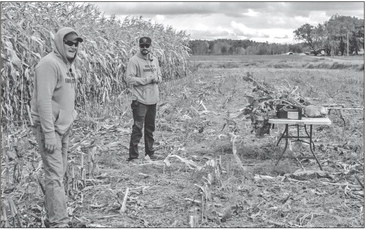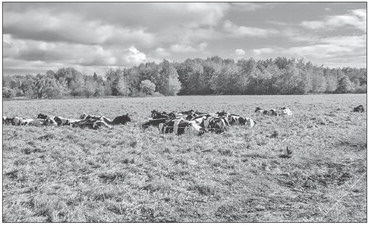EPPIC gives presentation on Nitrogen Use Efficiency


In 2021 UW-Madison Extension created the Agriculture Water Quality Program to expand the Discovery Farms program to conduct field research with, and for farmers, for onfield research of water quality and managing field fertility. One of the onfield research projects is the Nitrogen Use Efficiency Project, which evaluates nitrogen management practices in cropping systems.
On October 6, Short Lane Ag Supply co-hosted a field event with the Agriculture Water Quality Program and the farmer-led watershed group, Eau Pleine Partnership for Integrated Conservation at Mike Redetzke’s farm, located outside of Colby. Redetzke owns/manages a dairy heifer raising operation, that has row-crop and perennial forage acres, as well as grazing.
The field event was a showcasing of a season long Nitrogen Use Efficiency (NUE) project with silage corn, where field data was collected to evaluate the efficiency of nitrogen for the corn, and in the soil. The goal is to see if farmers can increase the effectiveness of nitrogen inputs, and if researchers can decrease the risk of nitrate leaching to groundwater.
The test trips were based on field conditions, and application rates of commercial fertilizer, or lack thereof. Three strips were applied with 183 credits of nitrogen (fall manure, popup fertilizer, 20 gallons/a of 28 percent at planting, and 20 gal/a of 28 percent Y-dropped at V10), on bare ground that was no-tilled, no-till after a 2021 cover crop, and no-till with interseeded companion crop. The last three strips were reduced of nitrogen, only getting 60 credits of nitrogen (fall manure with pop-up fertilizer, and no 28 percent). The field treatments (no till, cover crop, interseeding) were replicated.
“After I planted the corn, I thought that the ‘no-nitrogen’ side was going to be an absolute train wreck.” His immediate regret was that the corn was right next to the road; where everyone could see it. “But once the corn came up, and the season went on, I couldn’t believe what I saw: green, tall corn.”
The data also continued to surprise him, and everyone else in attendance at the field day. The second highest yielding corn was in the 60 credit strip that was planted after a cover crop, yielding 25.8 ton/a (8.4 dry matter yield/a), which was only 1.1 ton/a less than the best yield in the 183 credit strip.
“With 277 percent nitrogen uptake, the corn was able to not just utilize the manure, but gained more from the nutrient release of the cover crop. If we give this soil a chance, take care of it, it will give back.”
The event also included an overview of the Peaceful Creek Acres’ grazing and custom heifer raising operation. Along with beef cattle he is raising 200 dairy heifers from three area dairy farms, part of which is done through rotational grazing. The concept is to have livestock on the land for better health of the animal, and for the soil.
“The most important soil health principle is incorporating livestock on the land using managed grazing, and Mike is doing that in his farming system.”
Custom heifer raising has been a developing topic in the area, where smaller farms would take on heifers from larger dairies in the area, instead of them being shipped out of state, such as Nebraska. Once they have made it to a specific weight gain, they are brought back to the dairy.
The advantage is keeping local animals on local farms, and having them on pasture. Redetzke also explained that grazing brings optimal time and land management. “I have more flexibility when I have these animals out on pasture; just have to move a wire and their water once and while…And it was an easy choice, too, because these fields would channel (erode) so bad. When I see soil move, it’s money leaving my field.”
“With this hybrid system, using conservation in his row cropping, and implementing grazing, it is a level of management that we need in our watershed to see change downstream” Bembeneck said.
Since Redetzke has used rotational grazing on fields near Randall Creek, the clarity of the water has improved. “That creek was brown, dark brown when we moved here. Now my kids come with me to see fish, swimming around the rocks. We never saw that before.” In attendance was Amber Radatz, Agriculture Water Quality Program Manager at the University of Wisconsin.
Radatz commented that well-managed grazing has that immediate impact; because the organic matter increases, which also increases the stability of the soil, and the nutrients holds.
The presenters from EPPIC, Short Lane Ag Supply, and Agriculture Water Quality explained that farmers can use a variety of tools to make nitrogen management decisions, and in field data collection is one of the best ones. If the goal is to decrease the risk of nitrate leaching to groundwater, then evaluating and increasing the efficiency of nitrogen inputs becomes critical.
Radatz emphasized, “to tackle this challenge, we need to think across the whole landscape, and include tools like NUE, crop rotations, cover crops, and proper manure crediting…to develop a farming system that balances profitability with water quality.”

GRAZIN’ -The second half of the presentation focused on how to utilize managed grazing to benefit both livestock and the land.SUBMITTED PHOTO
